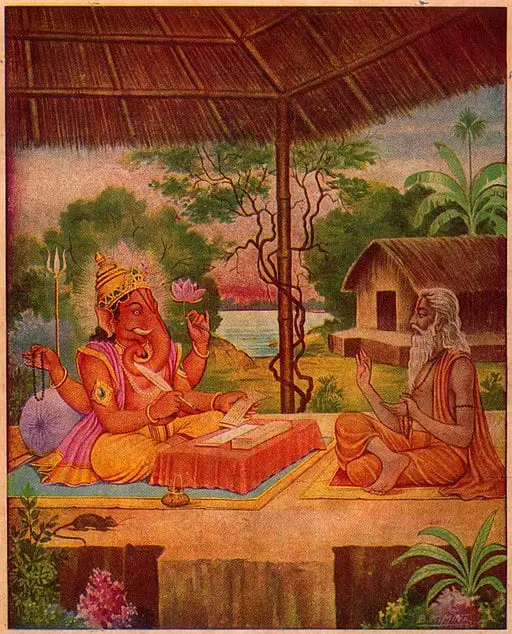Shloka vs. Mantra Let’s understand some basics and examples
A Shloka is a specific type of verse in classical Sanskrit poetry, usually consisting of four pādas or quarter-verses, of 8 syllables each.
It is the basis for Indian epic poetry and is used in many works of classical Sanskrit literature, such as the Mahabharata, the Ramayana, the Puranas, Smritis, and scientific treatises of Hinduism.
So, while a Shloka has to be composed in a specific metre (chhanda), with a specific number of lines with a specific number of words per line, each word could be a mantra. For example, viṣṇu sahastranāma is in anuṣṭup chhanda (two lines of four words each).
The Ramayana is an ancient Indian epic poem that tells the story of Rama, an incarnation of the god Vishnu, and his quest to rescue his wife Sita from the demon king Ravana. The Ramayana is full of beautiful shlokas (verses) that convey deep wisdom and insight.
Here are some examples of beautiful shlokas from the Ramayana:
- तपस्स्वाध्यायनिरतं तपस्वी वाग्विदां वरम् । नारदं परिपप्रच्छ वाल्मीकिर्मुनिपुङ्गवम् ।।1.1.1।। This shloka translates to “Ascetic Valmiki enquired of Narada, preeminent among the sages ever engaged in the practice of religious austerities or study of the Vedas and best among the eloquent”.
- कोन्वस्मिन्साम्प्रतं लोके गुणवान्कश्च वीर्यवान् । धर्मज्ञश्च कृतज्ञश्च सत्यवाक्यो दृढव्रत:।।1.1.2।। This shloka translates to “Who in this world lives today endowed with excellent qualities, prowess, righteousness, gratitude, truthfulness and firmness in his vows?”.
- चारित्रेण च को युक्तस्सर्वभूतेषु को हित: । विद्वान्क: कस्समर्थश्च कश्चैकप्रियदर्शन: ।।1.1.3।। This shloka translates to “Who is that one gifted with good conduct, given to the wellbeing of all living creatures, learned in the lore (knowledge of all things that is known), capable of doing things which others can not do and singularly handsome?”.
These shlokas are just a few examples of the many beautiful verses found in the Ramayana.
Another beautiful Sanskrit Shloka is:
उद्यमेन हि सिध्यन्ति कार्याणि न मनोरथैः। न हि सुप्तस्य सिंहस्य प्रविशंति मुखे मृगाः
The Hindi translation of this Shloka is: कोई भी काम उद्यम ( मेहनत ) से ही पूरा होता है, बैठे-बैठे हवाई किले बनाने से नहीं अर्थात सिर्फ सोचने भर से नहीं। ठीक उसी प्रकार सोते हुए शेर के मुंह में हिरण खुद नहीं चला जाता।
The English translation of this Shloka is: Any work is accomplished by hard work, not just by thinking. In the same way, As the deer does not enter the mouth of the sleeping lion.
On the other hand, a Mantra is a sacred utterance, sound, or group of words believed to have spiritual power. Mantras can be sounds, short texts, or long compositions.
The tiniest mantra is OM, while there are lengthy ones like the Gayatri mantra and Mahamritunjaya mantra.
A mantra is a word or phrase repeated in a prayer or meditative way. In Sanskrit, the word mantra can be broken down to “the root man- meaning ‘to think’ (also in manas ‘mind’) and the suffix -tra meaning ‘tool’, hence a literal translation would be ‘instrument of thought’.” The repetition of a mantra is thought to affirm its meaning to ourselves and change our thought process. It has the potential to cement a belief into our core being. Mantras tend to be short so they’re easy to remember and say repeatedly.
Some beautiful Sanskrit mantras which are similar to positive affirmations:
- Ānanda Hum — आनन्दः हूँ: This mantra translates to “I am bliss”³.
- Samprati Hum — सम्प्रति हूँ: This mantra translates to “I am present” or “I am now”.
- Kṛtajña Hum — कृतज्ञ हूँ: This mantra translates to “I am grateful” or “I am thankful”.
- Sampoorna Hum — संपूर्ण हूँ: This mantra translates to “I am complete”.
- Shanti Hum — शांति हूँ: This mantra translates to “I am peace”.
- Ahaṁ Brahmāsmi — अहम् ब्रह्मास्मि: This mantra translates to “I am absolute”.
These mantras can be used in meditation or in any moment of stillness. The repetition of these mantras can help to calm the mind and bring inner peace.
Remember, the power of a mantra comes from its meaning and the intention behind its use.

